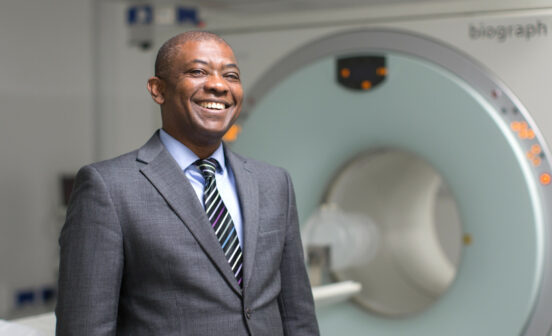Therapeutic Prostate cancer focal therapy is cost effective and may improve patient outcomes

Minimally invasive focal therapies for prostate cancer are associated with a lower overall cost and improved quality of life for patients.
These are the findings of a new study, published recently in the Journal of Medical Economics, and led by NIHR Imperial BRC researchers from Imperial College London.
It shows that when compared to surgery or radiotherapy, focal therapies for prostate cancer such as cryotherapy and High Intensity Focused Ultrasound (HIFU) are associated with a lower overall cost and improved quality of life.
By using cryotherapy to freeze or HIFU to heat only the areas of cancer in the prostate, the normal tissue of the prostate is left intact. This leads to less collateral tissue damage to surrounding nerves, blood vessels, and muscles.
As a result, focal therapy is associated with a lower risk of urinary, sexual and bowel side effects compared to prostatectomy surgery or radiotherapy.
“Our study is the first to show that focal therapy, using either cryotherapy or high-intensity focused ultrasound (HIFU) to destroy prostate cancers, was associated with a lower overall cost and improved quality of life for patients compared to either surgery or radiotherapy.” Professor Hashim AhmedChair of Urology at Imperial College London, and Consultant Urological Surgeon at Imperial College Healthcare NHS Trust
Currently, few patients in the UK receive focal therapy for prostate cancer, compared to surgically removing or irradiating the whole prostate gland.
In the latest study, a collaborative project between Boston Scientific and researchers at Imperial College London, along with Imperial College Healthcare NHS Trust and others, researchers analysed data from over 1,300 patients treated at five hospitals between 2006–2018.
The team developed an economic model to compare costs and outcomes following focal therapy as well as those having prostatectomy surgery or radiotherapy for up to 10 years after treatment.
Previously collected information from patients undergoing treatment for prostate cancer, together with published literature and clinical opinion, was used to predict the treatment pathway, costs incurred and the results of treatment in terms of patient benefits (effectiveness and quality of life).
They found that focal therapy – using either cryotherapy or HIFU – was associated with a lower overall cost and higher patient benefit than either surgery or radiotherapy, indicating that focal therapy represents good value for money in the NHS. It was also associated with fewer sexual, urinary, and rectal side effects for patients.
Focal therapy was associated with greater quality-adjusted life year (QALY) gains at a lower overall cost than radical prostatectomy or external beam radiotherapy (EBRT).
Professor Hashim Ahmed, Chair of Urology at Imperial College London, and Consultant Urological Surgeon at Imperial College Healthcare NHS Trust, said: “Our study is the first to show that focal therapy, using either cryotherapy or high-intensity focused ultrasound (HIFU) to destroy prostate cancers, was associated with a lower overall cost and improved quality of life for patients compared to either surgery or radiotherapy.
“This is because focal therapy precisely targets individual cancers in the prostate leading to less tissue damage, quicker recovery and much fewer side-effects. The treatment is also effective at treating cancers. Most patients with prostate cancer currently have radical prostatectomy or radiotherapy which treats the whole prostate.
Xavier Bertrand, vice president of Peripheral Interventions for Boston Scientific in EMEA, said: “The research findings are great news for patients and great news for the healthcare system. The UK government has explicitly recognised the importance of medtech in improving outcomes for patients. Equal access to this minimally invasive cancer treatment could help to resolve the current disparities in the UK for patients with prostate cancer.”
The researchers highlight some limitations with the work, explaining the limited number of hospitals means that other potential treatment options were excluded and that limited data were available on later outcomes, and none on quality-of-life data, so literature-based estimates were used.
Professor Ahmed added: “Focal therapy represents good value for money in the NHS whilst at the same time lower side effects and improved quality of life compared to traditional treatments. It could benefit about 10,000 patients who are diagnosed with prostate cancer in the UK each year.”
The work was supported by the NIHR Imperial Biomedical Research Centre, and funded by Boston Scientific Corporation.
–
This article is copied from an Imperial News Story which is based on materials from Boston Scientific




